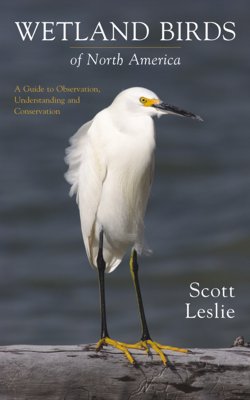
By Scott Leslie
Book Review
Wetland Birds of North America:
A Guide to Observation, Understanding and Conservation
Printer Friendly Page
Key Porter Books, Toronto, Ontario
$29.95 (CN), paperback, 312 pages, 2006)
Reviewed by Lee Bumsted
While this book was designed as a portable guide in a 5 x 8 inch format, it is also one that can be enjoyably thumbed through. Each of the 73 species selected for inclusion is illustrated by two or three of Leslie's vivid color photographs. Birds are shown in action: wading, taking off, flying, foraging, stalking prey, carrying fish, feeding young, landing. One photo shows a semi-palmated sandpiper in a downpour, another shows a common loon turning the eggs on its nest. As a novice birder, I found these striking photos of individual members of species caught my interest far more than the drawings often used in field guides, although I understand that drawings can better illustrate the species and their field marks.
Leslie did much of his fieldwork lying prone in a small floating blind, in all sorts of weather. He takes readers behind the scenes, sharing some of his techniques for observing and photographing birds and describing how he captured certain images. His extensive time spent at eye-level with the birds helps inform the text that accompanies these photos. Leslie, who lives near Annapolis Royal, Nova Scotia, won 2004 and 2005 Atlantic Journalism Awards for feature photojournalism. He contributes both photographs and articles to Birder's World and Canadian Wildlife.
Leslie's thorough descriptions of behavior help readers appreciate how wetland birds move about, feed and nest, all helpful clues when trying to identify a bird from a distance, and interesting in their own right. Each entry also has sections on appearance, habitat, calls, migration, and related species. The text keeps novice birders in mind; in the few cases where technical terms are used, they are defined clearly.
Something that sets this guide apart from others are the “conservation concerns” entries for each species. Here readers will learn if populations are stable or if there are threats to the birds and their habitats. Past threats such as hunting and DDT use along with current and future challenges such as habitat destruction are discussed. For instance, Leslie notes that piping plovers were almost hunted to extinction in the late nineteenth and early twentieth centuries, and they are considered endangered or threatened today due to development of their nesting habitat and human disturbance during their nesting season. For those birds whose populations are most threatened, color-coded conservation status maps are included.
Each species has at least three pages devoted to it. In contrast to some other bird guides, the text is uncluttered and easy to read. Range maps are on the small side, so if a bird lives just along the coast it may be hard to discern their range; written range descriptions might have worked better. Birds are grouped into seven categories: waterfowl; wading birds; birds of prey; rails; shorebirds, gulls, and terns; diving birds; and perching birds.
By selecting just 73 species, Leslie did not attempt to provide a comprehensive guide to all the birds that might use wetlands. As he notes, the ones chosen “are a representative selection of 'core' birds found throughout North American wetlands.” If you are trying to compare related species, this can be problematic. For instance, the herring gull is covered but the greater black-backed gull is not, so it's good to have another guide with more extensive coverage handy.
In one of the introductory chapters Leslie states: “It is my hope that the photographs and text...will inspire the reader to a greater curiosity and interest in wetland birds and the complex and fertile ecosystems they call home and, in doing so, help raise awareness of the critical need to protect them.” He reviews the various types of saltwater and freshwater wetlands found in North America, and laments their continuing loss due to agriculture and development. He concludes his book by listing 18 valuable wetland refuges and parks in Canada and 16 in the United States to help readers find the birds he has so clearly photographed.
© 2006 The Gulf of Maine Times
 North American wetlands are great places for viewing birds. Not only is there tremendous species diversity, but wetlands are often open spaces. As photographer and naturalist Scott Leslie notes in his attractive new field guide, wetland birds “don't have the option of flying just a few yards and disappearing into the heavy cover of trees.” Many wetland birds are large and some are quite distinctive. This can be particularly rewarding for casual or novice birders. Leslie has focused on just this group of birds in Wetland Birds of North America: A Guide to Observation, Understanding and Conservation.
North American wetlands are great places for viewing birds. Not only is there tremendous species diversity, but wetlands are often open spaces. As photographer and naturalist Scott Leslie notes in his attractive new field guide, wetland birds “don't have the option of flying just a few yards and disappearing into the heavy cover of trees.” Many wetland birds are large and some are quite distinctive. This can be particularly rewarding for casual or novice birders. Leslie has focused on just this group of birds in Wetland Birds of North America: A Guide to Observation, Understanding and Conservation.